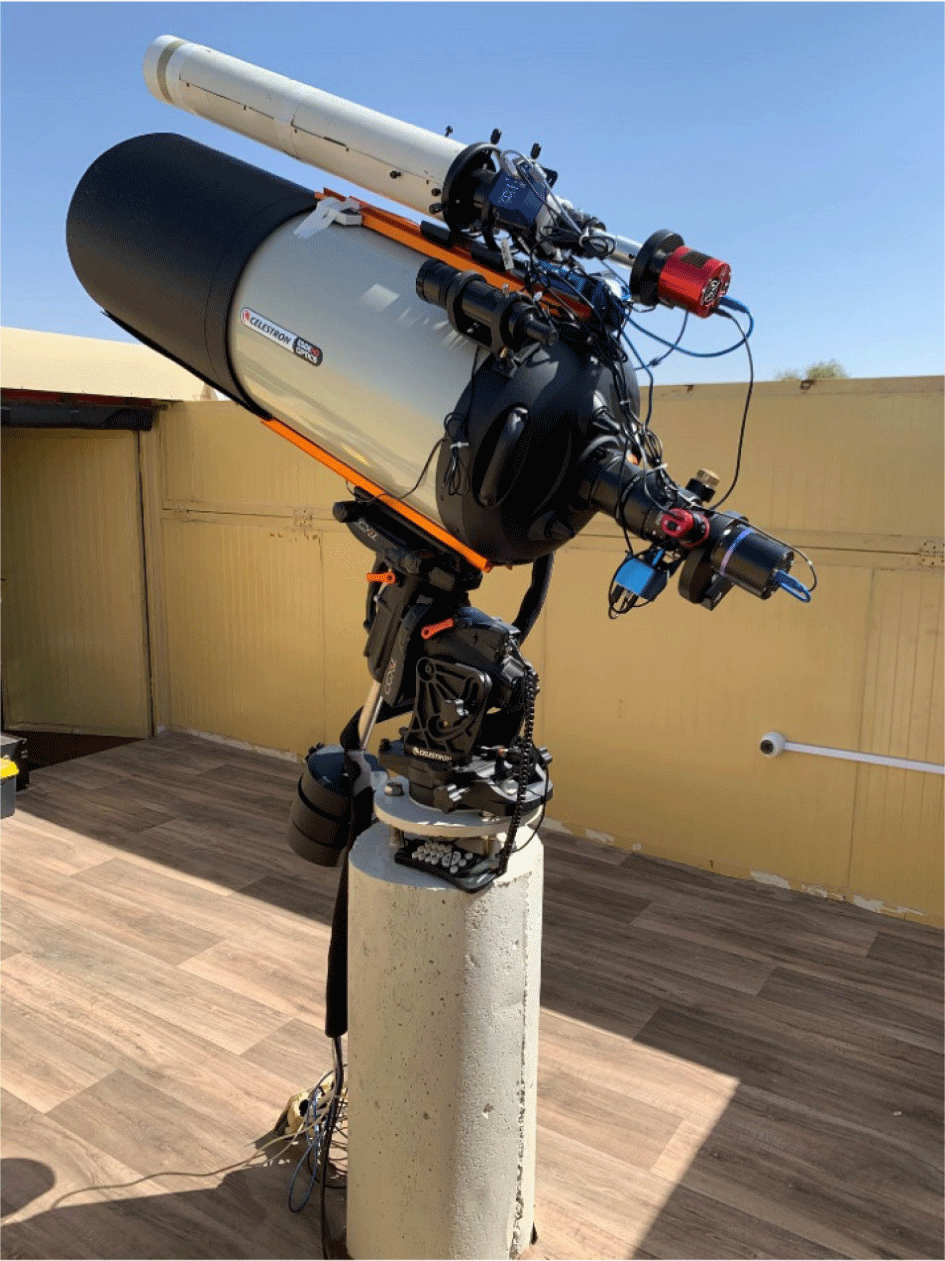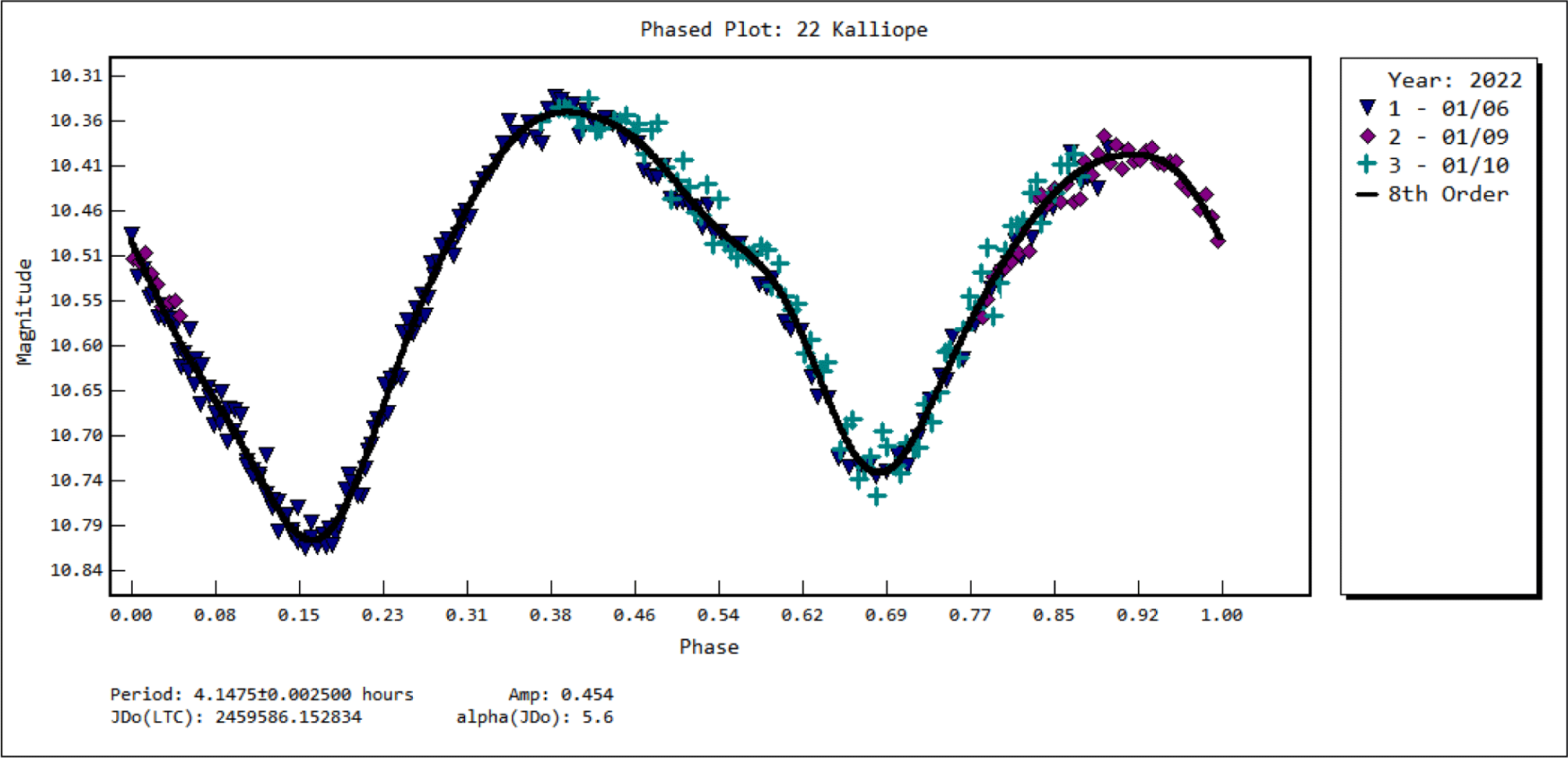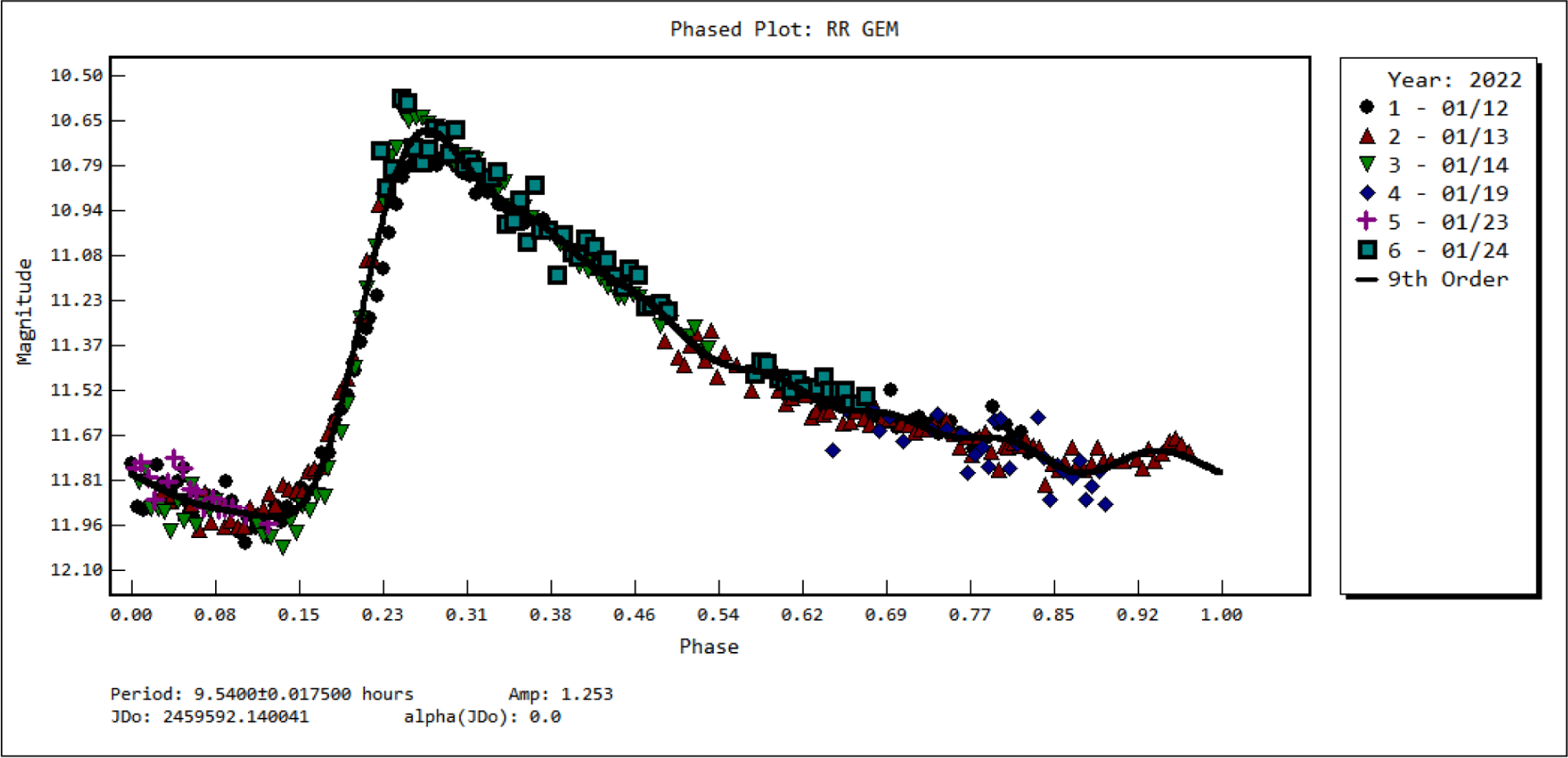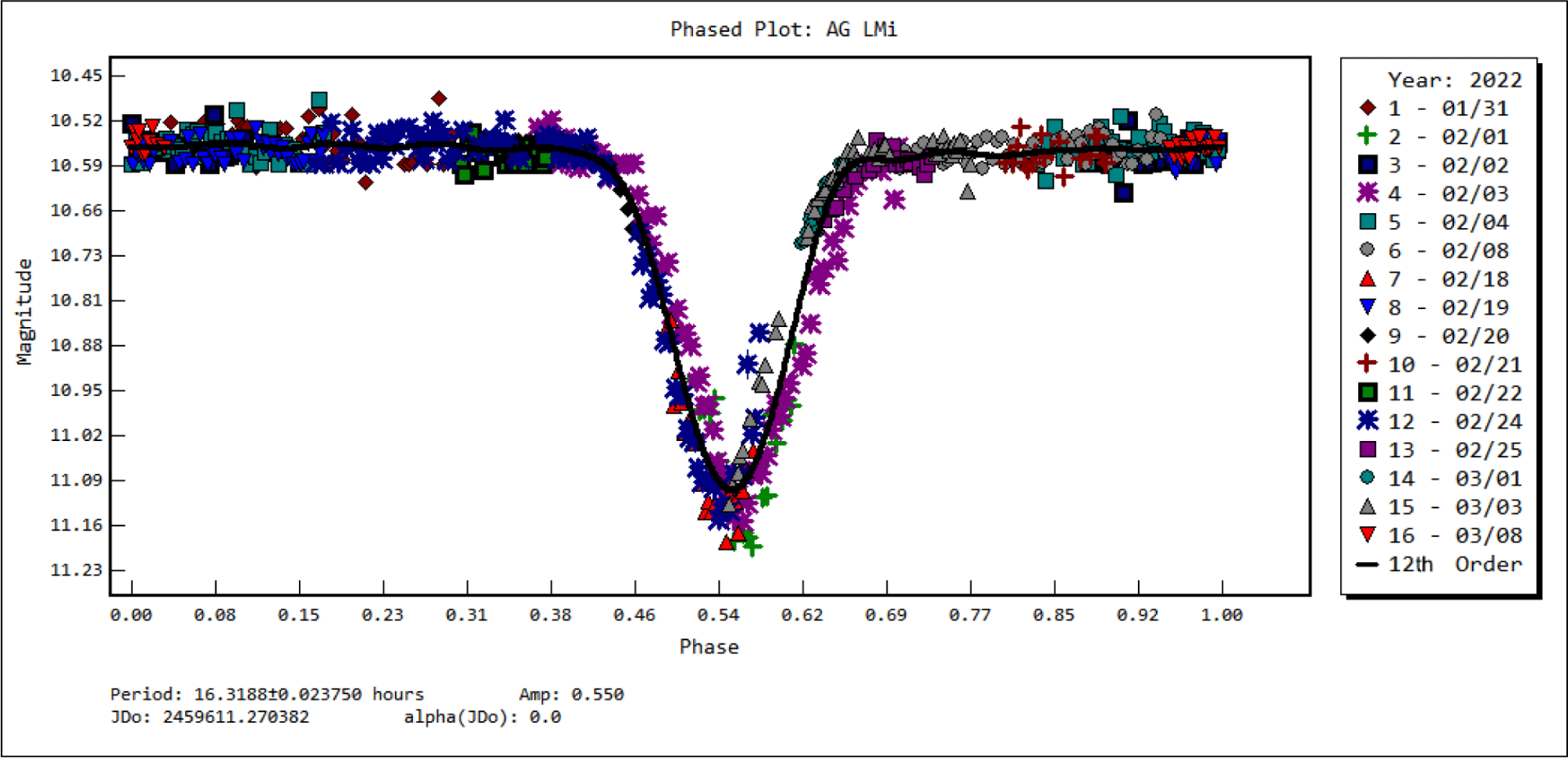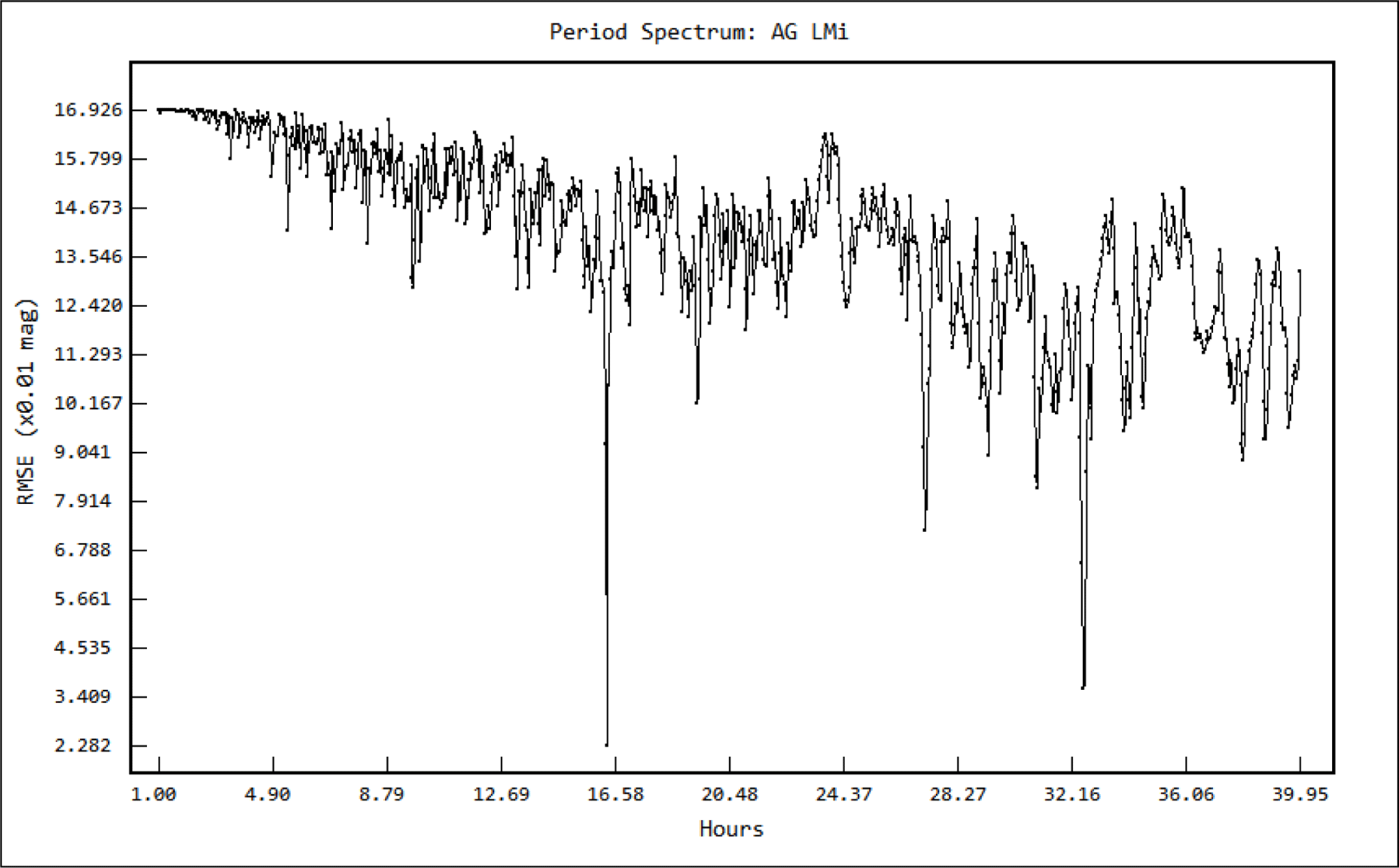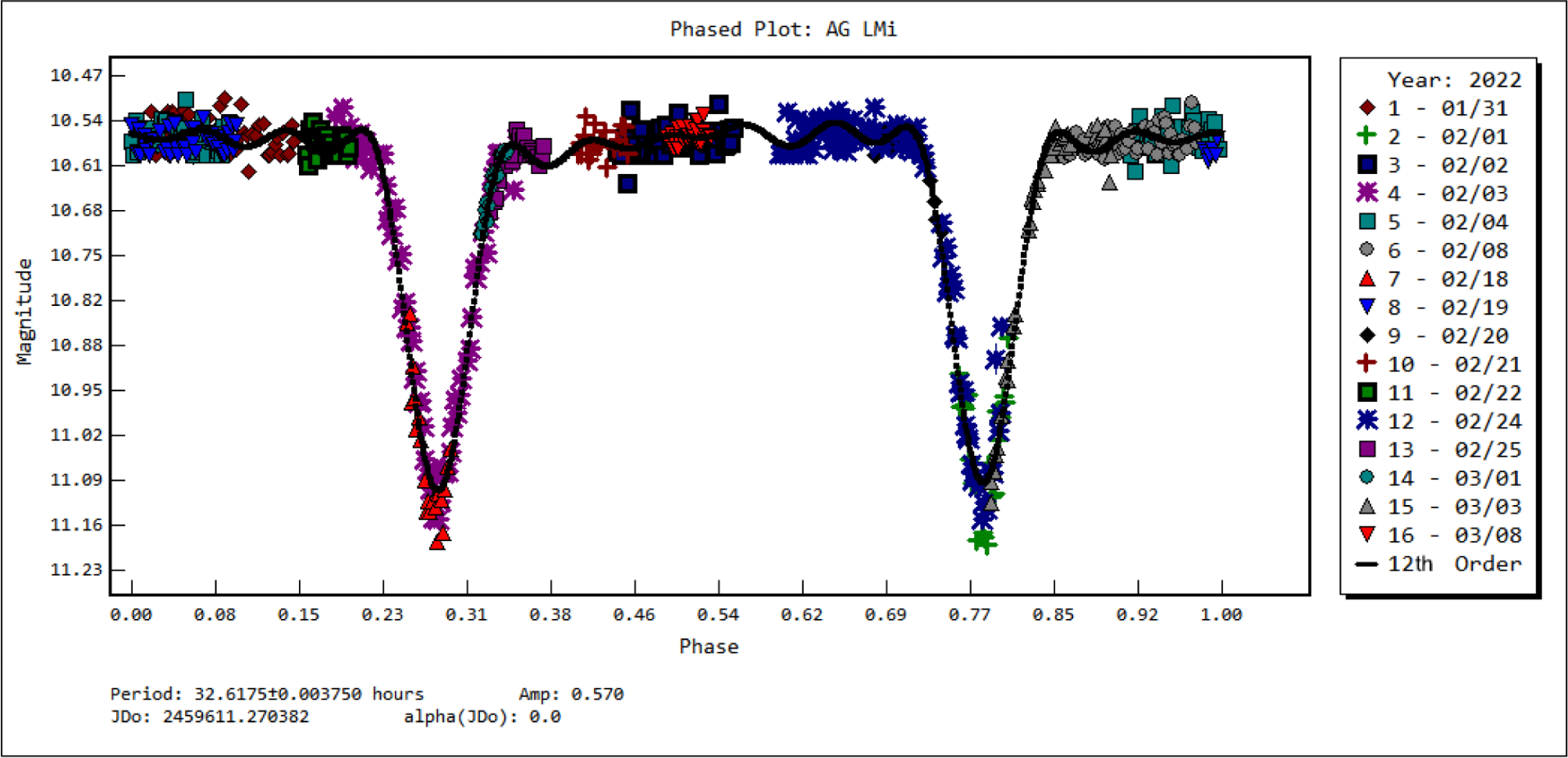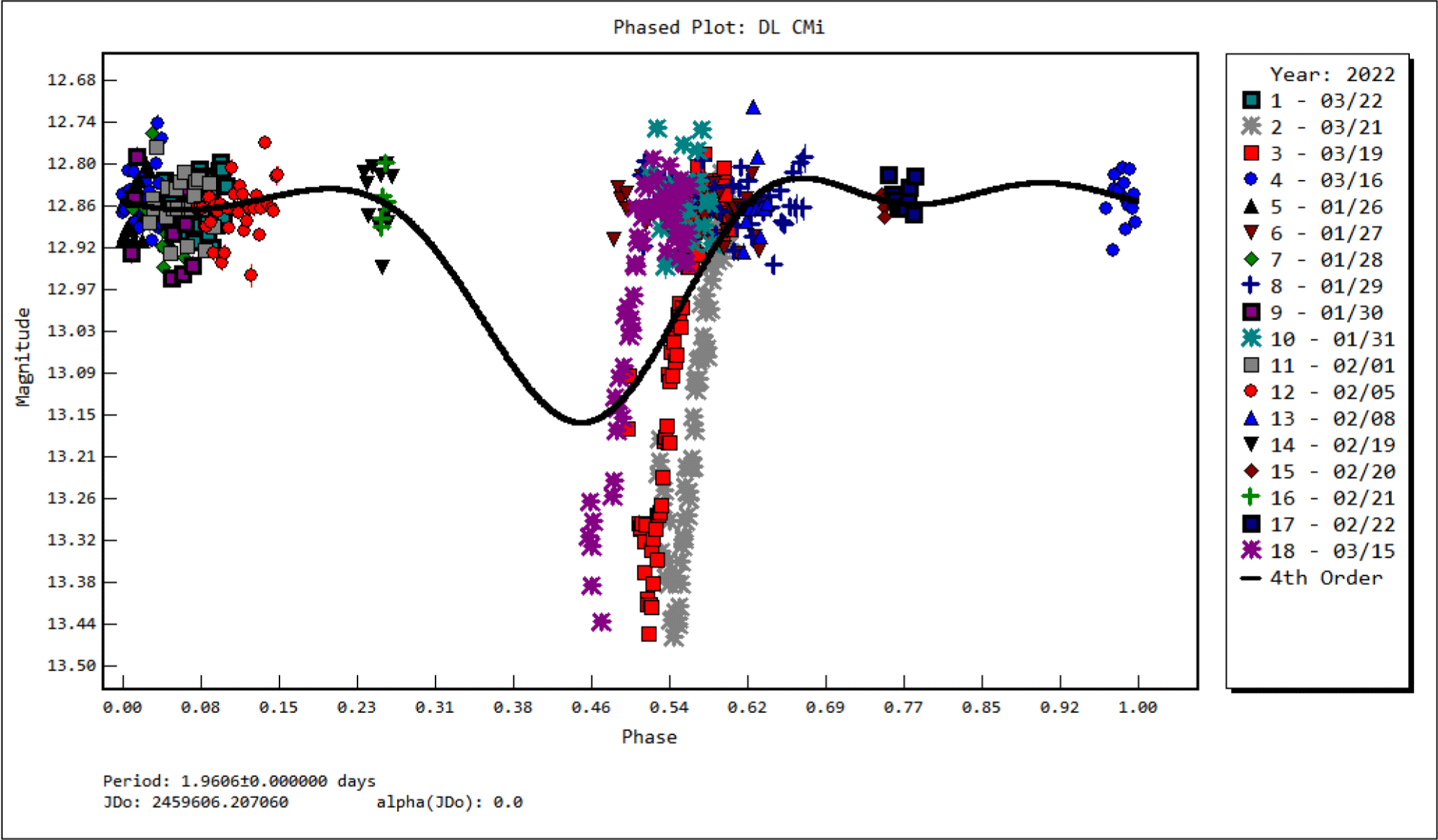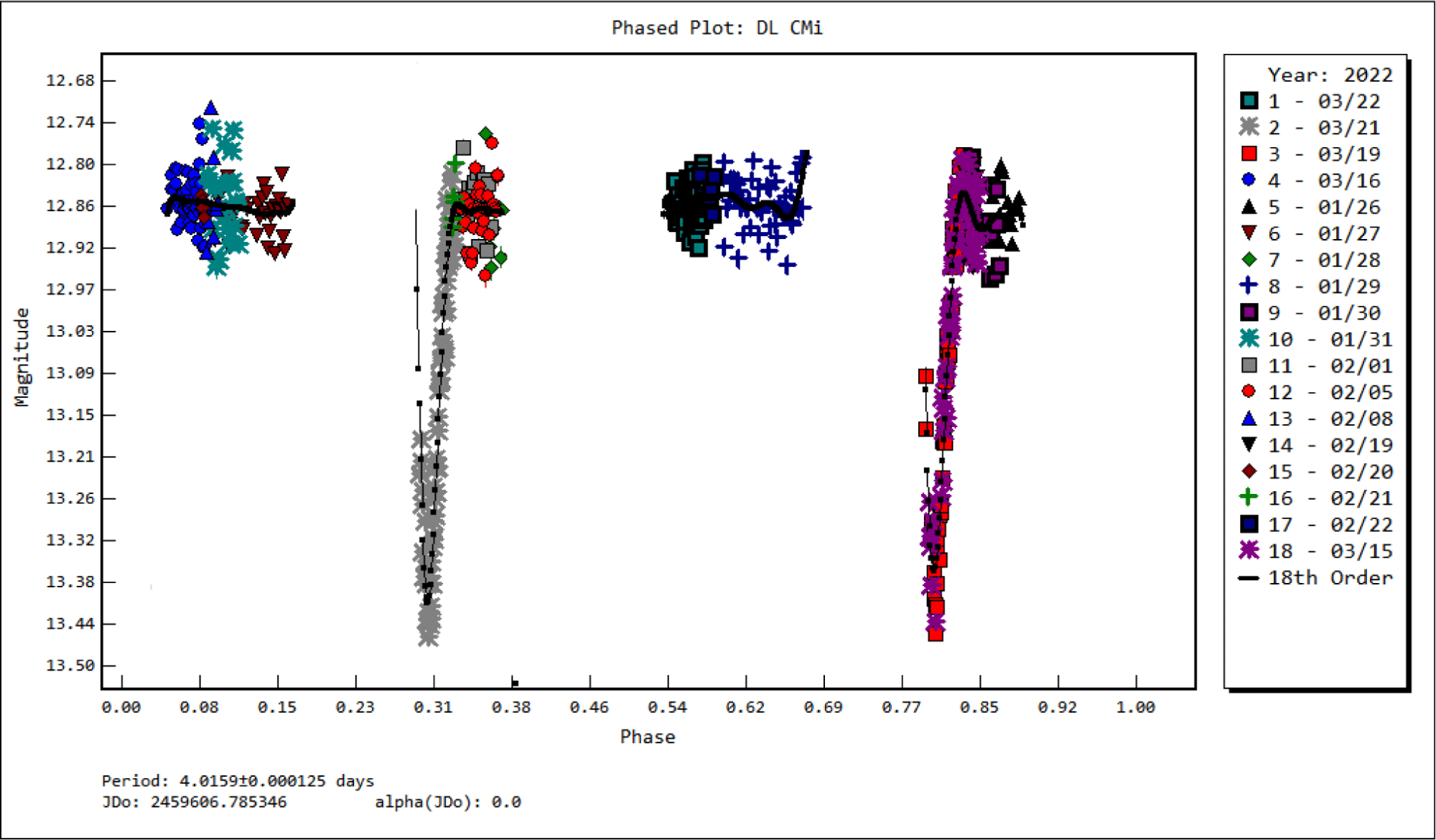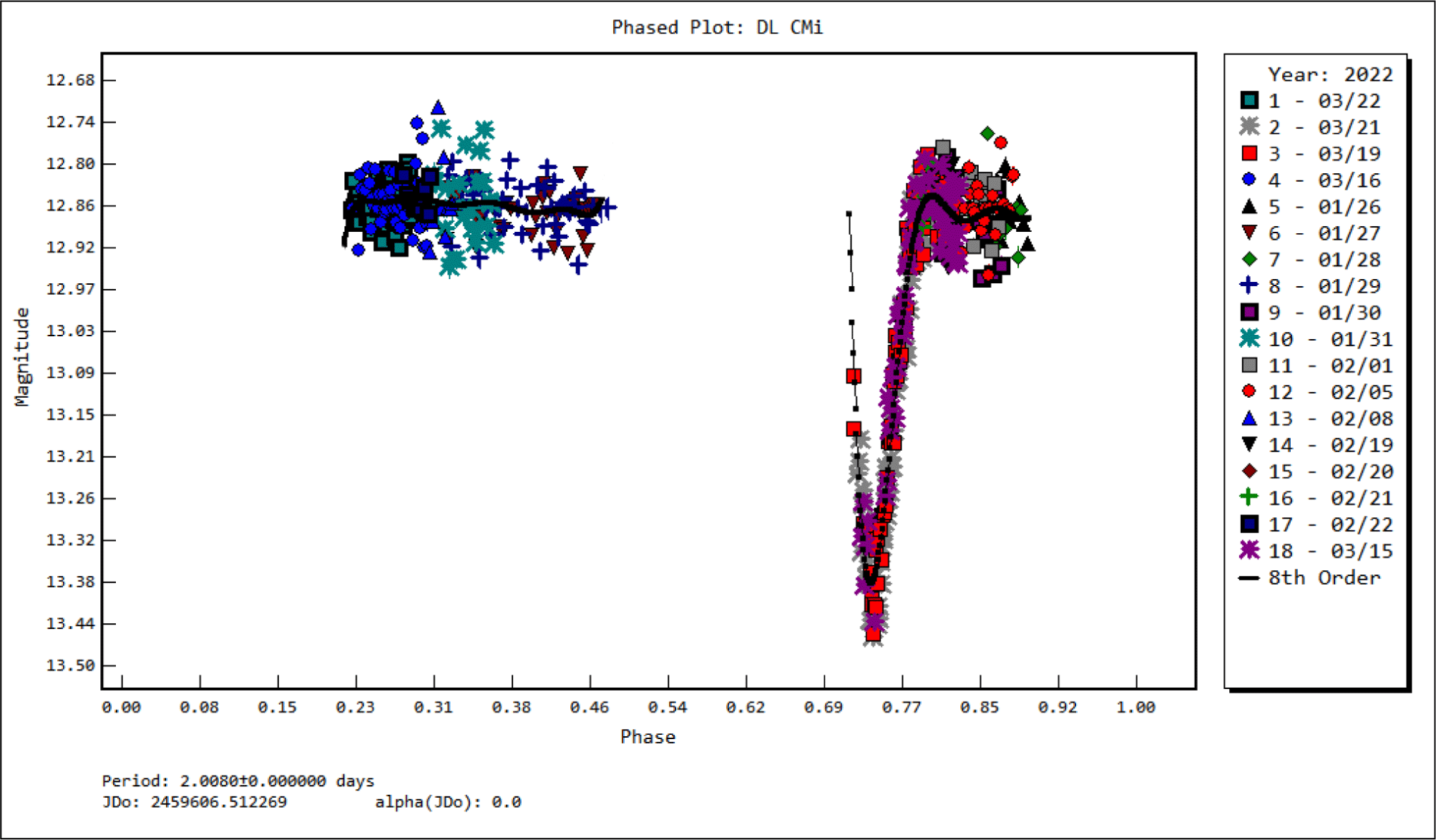1. INTRODUCTION
To involve Al Kahtim observatory [International Astronomical Union (IAU) Minor Planet Center (MPC) code M44] in scientific work, we used its small telescopes to observe some variable stars and an asteroid. The observations were focused on covering the full period of the light curve for each target. The targets were the three variable stars RR GEM, AG LMi and DL CMi and the asteroid 22 Kalliope.
The asteroid 22 Kalliope and the variable star RR GEM were selected because they have well-established light curves. Hence, they were used to ensure that the equipment and the reduction method were accurate and yielded reliable results. On the contrary, the variable stars AG LMi and DL CMi were selected owing to disagreements between the catalogs regarding their parameters, which are discussed in this work. For example, the star AG LMi has a period of 32.6164224 hours in one of the catalogs (Watson et al. 2006) and a period of 16.308168 hours in another catalogue (Samus’ et al. 2017). As for the star DL CMi, the period is 4.017282 days in one of the catalogs (Watson et al. 2006) and 1.960598 days in another catalogue (Watson et al. 2006).
2. METHODS
The following equipment was used to perform the photometry work.
Two telescopes were used to conduct the work. Observations made from January 06 to February 08, 2022, were performed using the following telescope:
-
- Explore Scientific 5” carbon fiber Triplet ED apochromatic refractor telescope
-
- Diameter: 12.7 cm
-
- Focal length: 952 mm
-
- Focal ratio: f/7.5
Observations made from February 18 to March 22, 2022, were made using a new telescope, as shown in Fig. 1, with the following specifications:
-
- Celestron 14” Aplanatic Schmidt–Cassegrain
-
- Diameter: 36 cm
-
- Focal length: 2,737 mm
-
- Focal ratio: f/7.7
After calibrating the images against the dark, flat, and bias frames and extracting the green channel, the software Tycho Tracker (Parrott 2020) was used to perform the photometry analysis. The software is quite powerful but easy to use, especially for selecting comparison stars and computing the variability period.
For all observed objects, some trials for the exposure time were conducted initially to ensure that the target is not saturated or in the nonlinearity zone. In addition, the comparison stars have magnitude and B–V values close to the target, and no variable star was selected as a comparison star.
The magnitude values of the comparison stars were obtained from the ATLAS catalogue, and the expressed magnitudes in the following graphs were Mv unless mentioned otherwise.
For AG LMi and DL CMi stars, to obtain accurate photometry measurements, the green channel was extracted to match an observation made with a mono camera using a V filter. As we used a color camera, the pixels of the sensor had three color filters, namely, red, green, and blue. The repeated pattern of these cameras comprised two green, one red, and one blue filters. Hence, to obtain standard results close to the green photometric filter, we used an image processing software to extract the results of the two green filters (channels) and combined them, which enabled us to obtain standard results as well as better signal-to-noise ratio (SNR) for our images.
The observatory was built by the International Astronomical Center (IAC) in the desert, approximately 60 km to the east of the United Arab Emirates (UAE) capital Abu-Dhabi, in an area called Al-Khatim. It is a robotic observatory, where the target objects are programed in advance. The roof opens automatically at the specified time, and after the observations are completed, it closes automatically too. The observatory is equipped with a weather station to close the roof in case of clouds or emergency.
The observatory was registered at the MPC of the IAU in February 2021 and was assigned the code M44. The objective of the observatory is to perform astrometry and photometry works, especially for asteroids and variable stars. Moreover, the observatory is involved in following the gamma-ray bursts and Kilonova events with an international team.
The observatory contains three telescopes: the main telescope, for three nights. Solar telescope, and a small telescope dedicated to lunar crescent observations. The seeing conditions at the observatory location are generally good; the average value is approximately 1.3”, and the full width at half maximum of the stars is usually < 3”.
3. PARAMETERS OF THE OBSERVED ASTEROID AND VARIABLE STARS
It is a large main-belt M-type asteroid, which has the following parameters (Johnston 2022):
It is an eclipsing binary (Algol-Type; EA) star. There is no agreement on the amplitude and period of this variable star, and the following are some examples:
The International Variable Star Index (VSX) (Watson et al. 2006):
The ASAS-SN all-sky catalog of bright variable stars (Jayasinghe et al. 2020):
General catalogue of variable stars, version GCVS 5.1 (Samus’ et al. 2017):
It is an eclipsing binary star of type EA. There is no agreement on the amplitude and period of this variable star, and the following are some examples:
The VSX (Watson et al. 2006):
General catalogue of variable stars, version GCVS 5.1 (Samus’ et al. 2017):
Catalogue of eclipsing variables, version 2 (Avvakumova et al. 2013):
The ASAS-SN all-sky catalog of bright variable stars (Jayasinghe et al. 2020):
The first catalog of variable stars measured with ATLAS (Heinze et al. 2018):
4. RESULTS AND DISCUSSION OF OBSERVATIONS
The asteroid was observed on three nights. Table 1 shows the number of images and the total observation time for each night. The exposure time was 15 seconds for each image. As the asteroid is a moving object, the comparison of stars varied from one day to another; however, the magnitudes of the comparison were always close to their magnitude.
| Date (local) | # of images | Total time |
|---|---|---|
| 06 Jan. 2022 | 187 | 5.4 h |
| 09 Jan. 2022 | 48 | 1.1 h |
| 10 Jan. 2022 | 88 | 2.1 h |
After analyzing the images with Tycho Tracker, the phased light curve corrected for the light time was obtained, as shown in Fig. 2. Light time correction is needed when observing asteroids because the distance between the earth and the asteroid keeps changing.
We found that the period was 4.1475 hours and the amplitude was 0.454, which are both in agreement with the published data.
The star was observed for six nights. Table 2 shows the number of images and the total observation time for each night.
| Date (local) | # of images | Total time |
|---|---|---|
| 12 Jan. 2022 | 115 | 7.854 h |
| 13 Jan. 2022 | 111 | 7.042 h |
| 14 Jan. 2022 | 75 | 4.980 h |
| 19 Jan. 2022 | 32 | 2.446 h |
| 23 Jan. 2022 | 18 | 1.222 h |
| 24 Jan. 2022 | 57 | 4.258 h |
The comparison stars that were used to determine the magnitude of the RR GEM variable star are listed in Table 3.
After analyzing the images with Tycho Tracker, the phased light curve depicted in Fig. 3 was obtained.
We found that the period was 9.54 hours and the amplitude was 1.253, which are both in agreement with the published data.
The star was observed for 16 nights. Table 4 shows the number of images and the total observation time for each night.
The comparison stars used to determine the magnitude of the AG LMi variable star are listed in Table 5.
After analyzing the images with the Tycho Tracker software, the best period obtained was 16.3188 hours, as shown in Fig. 4. This period had the lowest root mean square error (RMSE) value in the periodogram, as shown in Fig. 5.
This variability value agreed with that mentioned in the general catalogue for variable stars, as mentioned earlier. However, the light curve indicated the total disappearance of the secondary eclipse, which is possible if the secondary star is much fainter than the primary star.
Forcing the software to draw the light curve for the next period with the lowest RMSE value, we obtained a new light curve, as shown in Fig. 6, with a period of 32.6175 hours. Now, the primary and secondary eclipses were visible but identical, which can be explained only if the two stars are similar. Hence, we need more information on this binary to decide which of the two curves is correct.
This binary was studied by Mousavi-Sadr & Ebadi (2021), and we quote the following from their abstract:
“The combined photometric and spectroscopic solutions indicate that the system is a detached eclipsing binary system that consists of two similar components with a mass ratio of q~0.983. The spectral type of each component was estimated as F8, and the effective temperatures of components were calculated as T1 = 6,240 ± 19K and T2 = 6,220 ± 21K for the primary and secondary stars, respectively.”
As we now know that this binary system comprises two similar stars, we can exclude the first light curve and consider the second one with a period of 32.6175 hours and an amplitude of 0.57, which is in agreement with the published data in the VSX.
This star was observed for 18 nights. Table 6 shows the number of images and the total observation time for each night.
The comparison stars used to determine the magnitude of the DL CMi variable star are listed in Table 7.
We analyzed the observations using the Tycho Tracker software. The period published by ATLAS (Heinze et al. 2018) in the first catalog of variable stars is 1.960598 days, which is plotted in Fig. 7 against our observations. The figure shows that this period cannot be accurate as the minima are continuously shifted.
Fig. 8 shows the period predicted by the other above-mentioned catalogs, i.e., 4.0 days. The analysis indicated that the exact period is 4.0159 days with an amplitude of 0.6 mag, which is quite close to the period of 4.017 days specified in the mentioned catalogs.
Some studies have observed that the period of this star could be half of it, i.e., 2.008 days (Otero & Wils, 2005). As a test, Fig. 9 shows the light curve constructed assuming this period, from which the total absence of the secondary eclipse is evident. Hence, we believe that the period of 4 days is correct.
As the two minima in Fig. 8 are quite close to each other, we conclude that the two stars are twin or very similar stars. Thus, a spectroscopic observation of the star is highly recommended to confirm this conclusion.
5. CONCLUSION
With accurate observation and data reduction, reliable results can be achieved using a small telescope, thereby enabling participation in scientific work.
Although a color camera is generally not preferred in astronomy work, it can be used in the photometry of bright objects with some advantages, such as extracting the two green channels and combining them to obtain a better image with less SNR. In addition, red and blue channels can be extracted to obtain simultaneous multiband observation for a certain target, which offers more data in a shorter time.
The parameters of variable stars in some catalogs are not definite and may need extra work to confirm them.
According to previous studies, AG LMi has two suggested periods, i.e., 16.3 hours and 32.62 hours. Our results clearly confirm the second one, with an exact period of 32.6175 hours.
The star DL CMi has several suggested periods as per previous studies, such as 4.0173 days, 1.9606 days, and 2.0086 days. Our observations confirm the first one, with an exact period of 4.0159 days.










